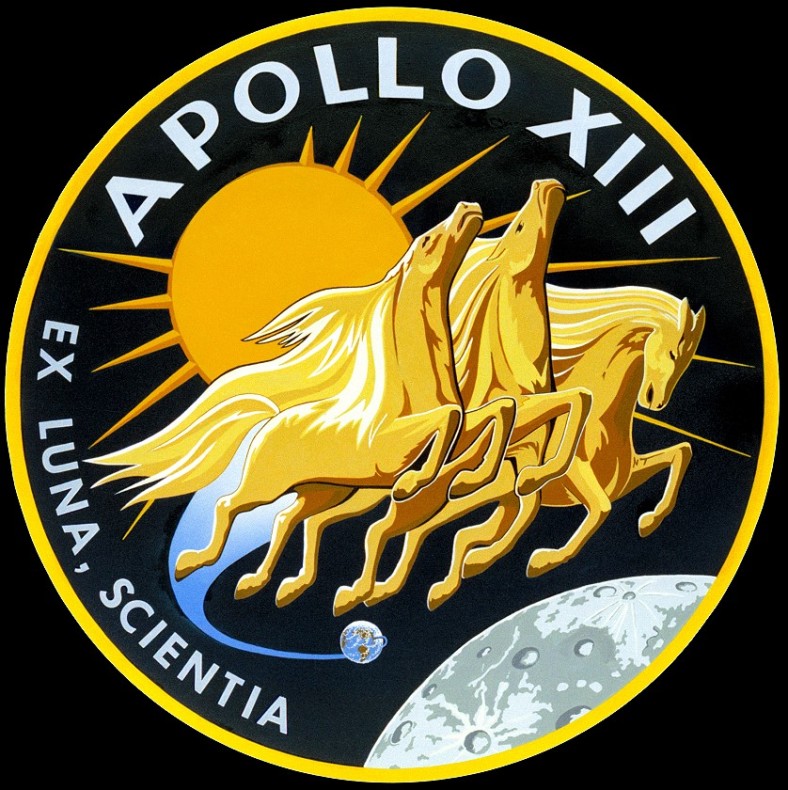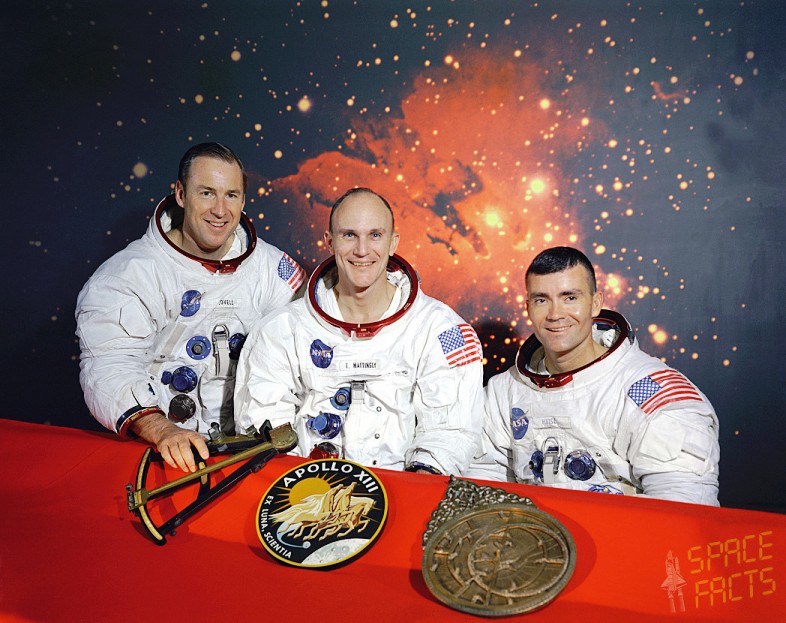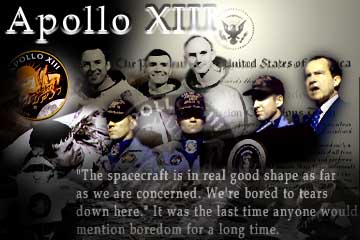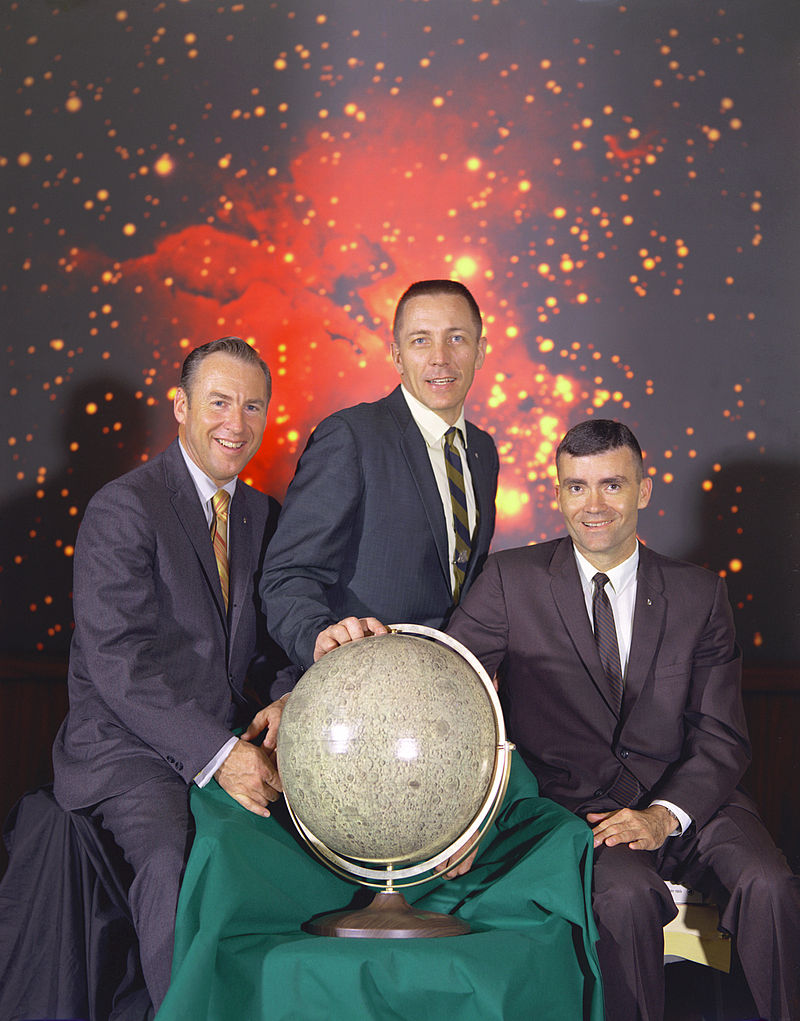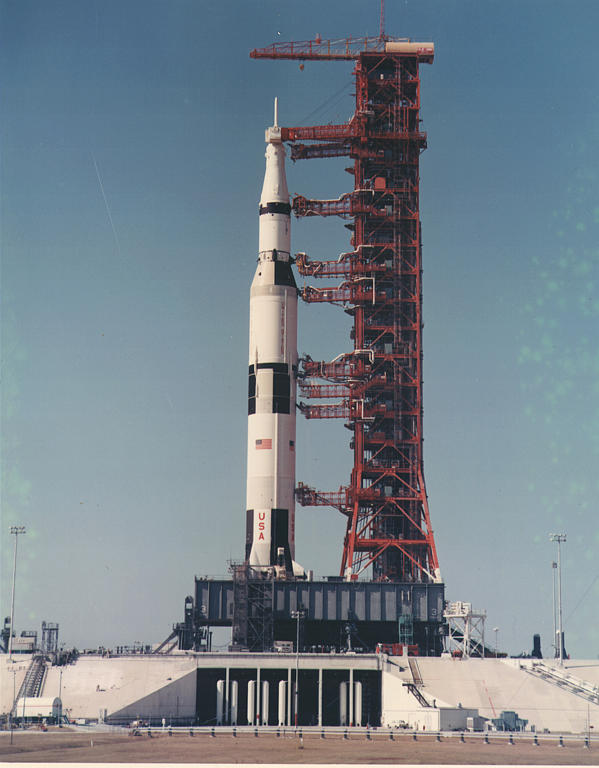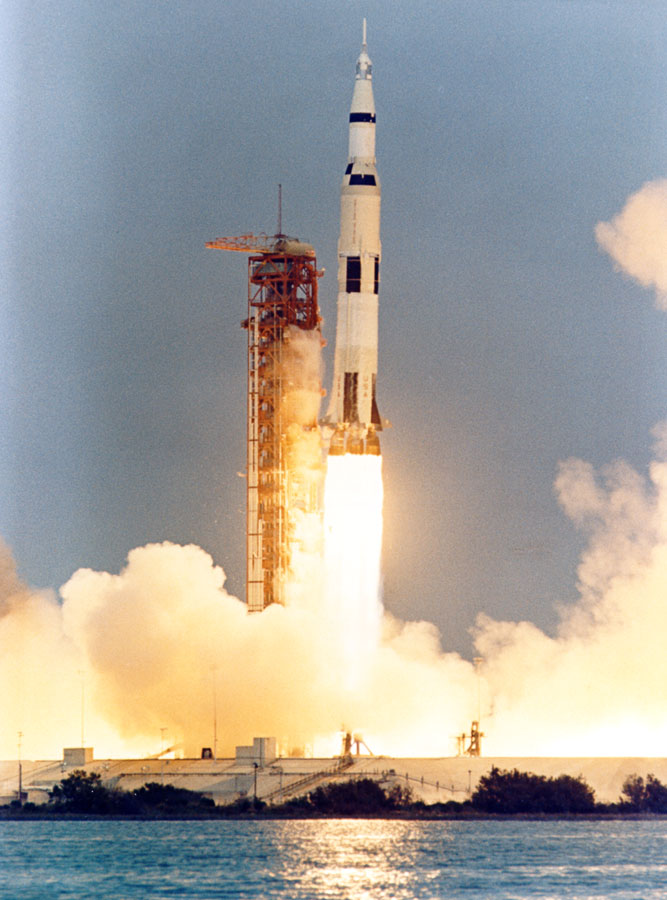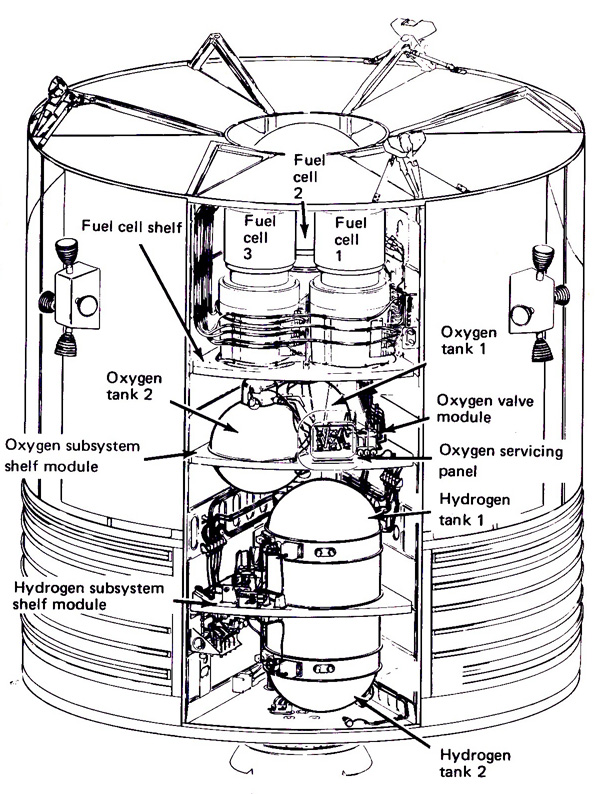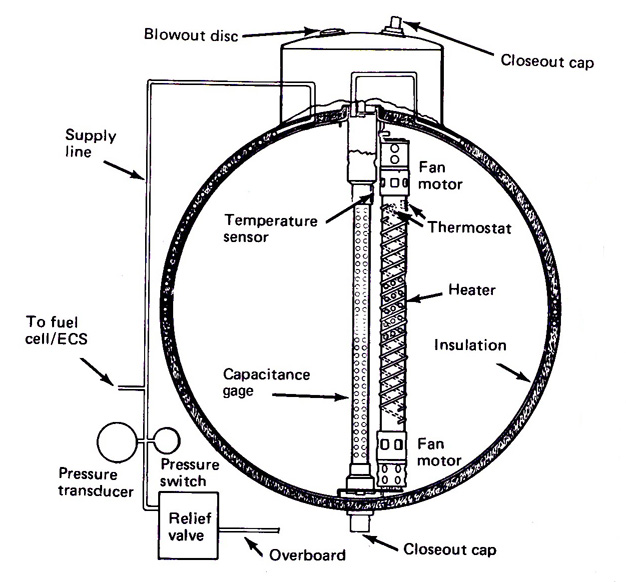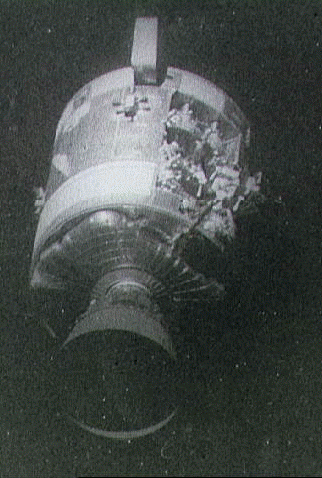
|
||||||||||||
|
|
|
Apollo 13
Pad 39-A (7) Saturn-V AS-508 () High Bay 1 MLP 3 Firing Room 1 Crew: James A. Lovell, Jr. John L. Swigert, Jr. Fred W. Haise, Jr.
Launched: 11 April 1970 UT 19:13:00
(02:13:00 p.m. EST)
"Houston, we have a problem..."
Apollo 13 was intended to be the third mission to carry humans to the surface of the Moon, but an explosion of one of the oxygen tanks and resulting damage to other systems resulted in the mission being aborted before the planned lunar landing could take place. The crew, commander James A. Lovell, Jr., command module pilot John L. Swigert, Jr., and lunar module pilot Fred W. Haise Jr., were returned safely to Earth on 17 April 1970.
Mission Profile Apollo 13 was launched on Saturn V SA-508 on 11 April 1970 at 19:13:00 UT (02:13:00 p.m. EST) from pad 39A at Kennedy Space Center.
Apollo-13 (29) Crew: Backup Crew: Milestones: Payload: Mission Objective: Launch: At five and a half minutes after liftoff, Swigert, Haise, and Lovell felt a little vibration. Then the center engine of the S-II stage shut down two minutes early. This caused the remaining four engines to burn 34 seconds longer than planned, and the S-IVB third stage had to burn nine seconds longer to put Apollo 13 in orbit. Days before the mission, backup LM pilot Charlie Duke inadvertently exposed the crew to German measles. Command module pilot, Ken Mattingly, turned out to have no immunity to measles and was replaced by backup command module pilot Jack Swigert. Ground tests before launch, indicated the possibility of a poorly insulated supercritical helium tank in the LM's descent stage so the flight plan was modified to enter the LM three hours early in order to obtain an onboard readout of helium tank pressure. The No. 2 oxygen tank,
serial number 10024X-TA0009 had been previously installed in the service
module of Apollo 10, but was removed for modification (and was damaged in
the process of removal). The tank was fixed, tested at the factory,
installed in the Apollo 13 service module. and tested again during the
Countdown Demonstration Test (CDT) at the Kennedy Space Center.beginning
March 16, 1970. The tanks normally are emptied to about half full, and No.
1 behaved all right. But No. 2 dropped to only 92 percent of capacity.
Gaseous oxygen at 80 psi was applied through the vent line to expel the
liquid oxygen, but to no avail. An interim discrepancy report was written,
and on March 27, two weeks before launch, detanking operations were
resumed. No. 1 again emptied normally, but No. 2 did not. After a
conference with contractor and NASA personnel, the test director decided
to "boil off" the remaining oxygen in No. 2 by using the electrical heater
within the tank. The technique worked, but it took eight hours of 65-volt
DC power from the ground-support equipment to dissipate the oxygen. Due to
an oversight in replacing an underrated component during a design
modification, this turned out to severely damage the internal heating
elements of the tank. Orbit: Landing: Mission Highlights: The first two days the crew ran into a couple of minor surprises, but generally Apollo 13 was looking like the smoothest flight of the program. At 46 hours 43 minutes Joe Kerwin, the CapCom on duty, said, "The spacecraft is in real good shape as far as we are concerned. We're bored to tears down here." It was the last time anyone would mention boredom for a long time. At 55 hours 46 minutes, as the crew finished a 49-minute TV broadcast showing how comfortably they lived and worked in weightlessness, Lovell stated: "This is the crew of Apollo 13 wishing everybody there a nice evening, and we're just about ready to close out our inspection of Aquarius (the LM) and get back for a pleasant evening in Odyssey (the CM). Good night." Nine minutes later, Oxygen tank No. 2 blew up, causing No. 1 tank also to fail. The Apollo 13 command modules normal supply of electricity, light, and water was lost, and they were about 200,000 miles from Earth. The message came in the form of a sharp bang and vibration. Jack Swigert saw a warning light that accompanied the bang, and said, "Houston, we've had a problem here." Lovell came on and told the ground that it was a main B bus undervolt. The time was 2108 hours on April 13. Next, the warning lights indicated the loss of two of Apollo 13's three fuel cells, which were the spacecrafts prime source of electricity. With warning lights blinking on, One Oxygen tank appeared to be completely empty, and there were indications that the oxygen in the second tank was rapidly being depleted. Thirteen minutes after the explosion, Lovell happened to look out of the left-hand window, and saw the final evidence pointing toward potential catastrophe. "We are venting something out into the- into space," he reported to Houston. Jack Lousma, the CapCom replied, "Roger, we copy you venting." Lovell said, "It's a gas of some sort." It was oxygen gas escaping at a high rate from the second, and last, oxygen tank. (by James A. Lovell, from
Apollo Expeditions to the Moon, edited The first thing the crew did, even before discovering the oxygen leak, was to try to close the hatch between the CM and the LM. They reacted spontaneously, like submarine crews, closing the hatches to limit the amount of flooding. First Jack and then Lovell tried to lock the reluctant hatch, but the stubborn lid wouldn't stay shut. Exasperated, and realizing that there wasn't a cabin leak, they strapped the hatch to the CM couch. The pressure in the No. 1 oxygen tank continued to drift downward; passing 300 psi, now heading toward 200 psi. Months later, after the accident investigation was complete, it was determined that, when No. 2 tank blew up, it either ruptured a line on the No. 1 tank, or caused one of the valves to leak. When the pressure reached 200 psi, the crew and ground controllers knew that they would lose all oxygen, which meant that the last fuel cell would also die. At 1 hour and 29 seconds after the bang, Jack Lousma, then CapCom, said after instructions from Flight Director Glynn Lunney: "It is slowly going to zero, and we are starting to think about the LM lifeboat." Swigert replied, "That's what we have been thinking about too." Ground controllers in Houston faced a formidable task. Completely new procedures had to be written and tested in the simulator before being passed up to the crew. The navigation problem had to be solved; essentially how, when, and in what attitude to burn the LM descent engine to provide a quick return home. With only 15 minutes of power left in the CM, CapCom told the crew to make their way into the LM. Fred and Jim Lovell quickly floated through the tunnel, leaving Jack to perform the last chores in the Command Module. The first concern was to determine if there were enough consumables to get home? The LM was built for only a 45-hour lifetime, and it needed to be stretch to 90. Oxygen wasn't a problem. The full LM descent tank alone would suffice, and in addition, there were two ascent-engine oxygen tanks, and two backpacks whose oxygen supply would never be used on the lunar surface. Two emergency bottles on top of those packs had six or seven pounds each in them. (At LM jettison, just before reentry, 28.5 pounds of oxygen remained, more than half of what was available after the explosion). Power was also a concern. There were 2181 ampere hours in the LM batteries, Ground controllers carefully worked out a procedure where the CM batteries were charged with LM power. All non-critical systems were turned off and energy consumption was reduced to a fifth of normal, which resulted in having 20 percent of our LM electrical power left when Aquarius was jettisoned. There was one electrical close call during the mission. One of the CM batteries vented with such force that it momentarily dropped off the line. Had the battery failed, there would be insufficient power to return the ship to Earth. Water was the main consumable concern. It was estimated that the crew would run out of water about five hours before Earth reentry, which was calculated at around 151 hours. However, data from Apollo 11 (which had not sent its LM ascent stage crashing into the Moon as in subsequent missions) showed that its mechanisms could survive seven or eight hours in space without water cooling. The crew conserved water. They cut down to six ounces each per day, a fifth of normal intake, and used fruit juices; they ate hot dogs and other wet-pack foods when they ate at all. The crew became dehydrated throughout the flight and set a record that stood up throughout Apollo: Lovell lost fourteen pounds, and the crew lost a total of 31.5 pounds, nearly 50 percent more than any other crew. Those stringent measures resulted in the crew finishing with 28.2 pounds of water, about 9 percent of the total. Removal of Carbon Dioxide was also a concern. There were enough lithium hydroxide canisters, which remove carbon dioxide from the spacecraft, but the square canisters from the Command Module were not compatible with the round openings in the Lunar Module environmental system. There were four cartridge from the LM, and four from the backpacks, counting backups. However, the LM was designed to support two men for two days and was being asked to care for three men nearly four days. After a day and a half in the LM a warning light showed that the carbon dioxide had built up to a dangerous level. Mission Control devised a way to attach the CM canisters to the LM system by using plastic bags, cardboard, and tape- all materials carried on board. One of the big questions was, "How to get back safely to Earth?" The LM navigation system wasn't designed to help us in this situation. Before the explosion, at 30 hours and 40 minutes, Apollo 13 had made the normal midcourse correction, which would take it out of a free-return-to-Earth trajectory and put it on a lunar landing course. Now the task was to get back on a free-return course. The ground computed a 35-second burn and fired it 5 hours after the explosion. As they approached the Moon, another burn was computed; this time a long 5-minute burn to speed up the return home. It took place 2 hours after rounding the far side of the Moon, The Command Module navigational platform alignment was transferred to the LM but verifying alignment was difficult. Ordinarily the alignment procedure uses an onboard sextant device, called the Alignment Optical Telescope, to find a suitable navigation star. Then with the help of the onboard computer verify the guidance platform's alignment. However, due to the explosion, a swarm of debris from the ruptured service module made it impossible to sight real stars. An alternate procedure was developed to use the sun as an alignment star. Lovell rotated the spacecraft to the attitude Houston had requested and when he looked through the AOT, the Sun was just where it was expected. The alignment with the Sun proved to be less than a half a degree off. The ground and crew then knew they could do the 5-minute P.C. + 2 burn with assurance, and that would cut the total time of our voyage to about 142 hours. At 73:46 hours the air-to-ground transcript describes the event: Lovell: O.K. We got it. I
think we got it. What diameter Haise: Yes. It's coming back in. Just a second. Lovell: Yes, yaw's coming back in. Just about it. Haise: Yaw is in.... Lovell: What have you got? Haise: Upper right corner of the Sun.... Lovell: We've got it! If we raised our voices, I submit it was justified. "I'm told the cheer of the year went up in Mission Control. Flight Director Gerald Griffin, a man not easily shaken, recalls: "Some years later I went back to the log and looked up that mission. My writing was almost illegible I was so damned nervous. And I remember the exhilaration running through me: My God, that's kinds the last hurdle -- if we can do that, I know we can make it. It was funny, because only the people involved knew how important it was to have that platform properly aligned." Yet Gerry Griffin barely mentioned the alignment in his change-of-shift briefing -- "That check turned out real well" is all he said an hour after his penmanship failed him. The trip was marked by discomfort beyond the lack of food and water. Sleep was almost impossible because of the cold. When the electrical systems were turned off, the spacecraft lost and important source of heat. The temperature dropped to 38 F and condensation formed on all the walls. A most remarkable achievement of Mission Control was quickly developing procedures for powering up the CM after its long cold sleep. Flight controllers wrote the documents for this innovation in three days, instead of the usual three months. The Command Module was cold and clammy at the start of power up. The walls, ceiling, floor, wire harnesses, and panels were all covered with droplets of water. It was suspected conditions were the same behind the panels. The chances of short circuits caused apprehension, but thanks to the safeguards built into the command module after the disastrous Apollo-1 fire in January 1967, no arcing took place. The droplets furnished one sensation as we decelerated in the atmosphere: it rained inside the CM. Four hours before landing, the crew shed the service module; Mission Control had insisted on retaining it until then because everyone feared what the cold of space might do to the unsheltered CM heat shield. Photos of the Service Module showed one whole panel missing, and wreckage hanging out, it was a sorry mess as it drifted away. Three hours later the crew left the Lunar Module Aquarius and then splashed down gently in the Pacific Ocean near Samoa, After an intensive investigation, the Apollo 13 Accident Review Board identified the cause of the explosion. In 1965 the CM had undergone many improvements, which included raising the permissible voltage to the heaters in the oxygen tanks from 28 to 65 volts DC. Unfortunately, the thermostatic switches on these heaters weren't modified to suit the change. During one final test on the launch pad, the heaters were on for a long period of time. "This subjected the wiring in the vicinity of the heaters to very high temperatures (1000 F), which have been subsequently shown to severely degrade teflon insulation. The thermostatic switches started to open while powered by 65 volts DC and were probably welded shut." Furthermore, other warning signs during testing went unheeded and the tank, damaged from 8 hours overheating, was a potential bomb the next time it was filled with oxygen. That bomb exploded on April 13, 1970 -- 200,000 miles from Earth.
A television broadcast was made from Apollo 13 from 02:24 UT to 02:59 UT on 14 April and a few minutes later, at 03:06:18 UT Jack Swigert turned the fans on to stir oxygen tanks 1 and 2 in the service module. The Accident Review Board concluded that wires which had been damaged during pre-flight testing in oxygen tank no. 2 shorted and the teflon insulation caught fire. The fire spread within the tank, raising the pressure until at 3:07:53 UT on 14 April (10:07:53 EST 13 April; 55:54:53 mission elapsed time) oxygen tank no. 2 exploded, damaging oxygen tank no. 1 and the interior of the service module and blowing off the bay no. 4 cover. With the oxygen stores depleted, the command module was unusable, the mission had to be aborted, and the crew transferred to the lunar module and powered down the command module.
The spacecraft was the second of the Apollo H-series. The purposes of the mission were (1) to explore the hilly upland Fra Mauro region of the moon, (2) to perform selenological inspection, survey, and sampling of material in the Fra Mauro formation, (3) to deploy and activate an Apollo lunar surface experiments package (ALSEP), (4) to further develop man's capability to work in the lunar environment, and (5) to obtain photographs of candidate lunar exploration sites. These goals were to be carried out from a near-circular lunar orbit and on the lunar surface at 3 deg S latitude, 17 deg W longitude. Although the planned mission objectives were not realized, a limited amount of photographic data was obtained. Lovell was a Navy captain on his fourth spaceflight (he'd flown previously on Gemini 7, Gemini 12, and Apollo 8), Haise and Swigert were both civilians on their first spaceflights. The backup crew was John Young, Charles Duke, and John Swigert (who replaced Thomas Mattingly on the prime crew after the crew was exposed to German measles). The Apollo 13 Command Module "Odyssey" is now at the Kansas Cosmosphere and Space Center, Hutchinson, Kansas. It was originally on display at the Musee de l'Air, Paris, France. Detailed Chronology of Events Surrounding the Apollo 13 accidentEvents from 2.5 minutes before the accident to about 5 minutes afterTimes given are in Ground Elapsed Time (G.E.T.), that is, the time elapsed since liftoff of Apollo 13 on 11 April 1970 at 19:13 UT (2:13 PM EST).55:52:00 G.E.T. is equal to 03:05:00 UT 14 April 1970 (10:05 PM April 13 EST).
55:52:31 - Master caution and warning triggered by low hydrogen
pressure in tank no. 1
55:52:58 - CapCom (Jack Lousma): "13, we've got one more item
for you, when you get a chance. We'd like you to stir up
the cryo tanks. In addition, I have shaft and trunnion .....
55:53:06 - Swigert: "Okay."
55:53:07 - Lousma: ".... for looking at Comet Bennett, if you
need it."
55:53:12 - Swigert: "Okay. Stand by."
55:53:18 - Oxygen tank No. 1 fans on.
55:53:19 - Oxygen tank No. 2 pressure decreases 8 psi.
55:53:20 - Oxygen tank No. 2 fans turned on.
55:53:20 - Stabilization control system electrical disturbance
indicates a power transient.
55:53:21 - Oxygen tank No. 2 pressure decreases 4 psi.
55:53:22.718 - Stabilization control system electrical
disturbance indicates a power transient.
55:53:22.757 - 1.2 Volt decrease in ac bus 2 voltage.
55:53:22.772 - 11.1 amp rise in fuel cell 3 current for one
sample
55:53:26 - Oxygen tank No. 2 pressure begins rise lasting for
24 seconds.
55:53:38.057 - 11 volt decrease in ac bus 2 voltage for one
sample.
55:53:38.085 - Stabilization control system electrical
disturbance indicates a power transient.
55:53:41.172 - 22.9 amp rise in fuel cell 3 current for one
sample
55:53:41.192 - Stabilization control system electrical
disturbance indicates a power transient.
55:54:00 - Oxygen tank No. 2 pressure rise ends at a pressure
of 953.8 psia.
55:54:15 - Oxygen tank No. 2 pressure begins to rise.
55:54:30 - Oxygen tank No. 2 quantity drops from full scale for
2 seconds and then reads 75.3 percent.
55:54:31 - Oxygen tank No. 2 temperature begins to rise rapidly.
55:54:43 - Flow rate of oxygen to all three fuel cells begins
to decrease.
55:54:45 - Oxygen tank No. 2 pressure reaches maximum value of
1008.3 psia.
55:54:51 - Oxygen tank No. 2 quantity jumps to off-scale high
and then begins to drop until the time of telemetry loss,
indicating failed sensor.
55:54:52 - Oxygen tank No. 2 temperature sensor reads -151.3 F.
55:54:52.703 - Oxygen tank No. 2 temperature suddenly goes
off-scale low, indicating failed sensor.
55:54:52.763 - Last telemetered pressure from oxygen tank
No. 2 before telemetry loss is 995.7 psia.
55:54:53.182 - Sudden accelerometer activity on X, Y, Z axes.
55:54:53.220 - Stabilization control system rate changes begin.
55:54:53.323 - Oxygen tank No. 1 pressure drops 4.2 psi.
55:54:53.500 - 2.8 amp rise in total fuel cell current.
55:54:53.542 - X, Y, and Z accelerations in CM indicate 1.17g,
0.65g, and 0.65g.
55:54:53.555 - Master caution and warning triggered by DC main
bus B undervoltage. Alarm is turned off in 6 seconds. All
indications are that the cryogenic oxygen tank No. 2 lost
pressure in this time period and the panel separated.
55:54:54.741 - Nitrogen pressure in fuel cell 1 is off-scale
low indicating failed sensor.
55:54:55.350 - Telemetry recovered.
55:54:56 - Service propulsion system engine valve body
temperature begins a rise of 1.65 F in 7 seconds. DC main
bus A decreases 0.9 volts to 28.5 volts and DC main bus B
0.9 volts to 29.0 volts. Total fuel cell current is 15
amps higher than the final value before telemetry loss.
High current continues for 19 seconds. Oxygen tank No. 2
temperature reads off-scale high after telemetry recovery,
probably indicating failed sensors. Oxygen tank No. 2
pressure reads off-scale low following telemetry recovery,
indicating a broken supply line, a tank pressure below
19 psi, or a failed sensor. Oxygen tank No. 1 pressure
reads 781.9 psia and begins to drop.
55:54:57 - Oxygen tank No. 2 quantity reads off-scale high
following telemetry recovery indicating failed sensor.
55:55:01 - Oxygen flow rates to fuel cells 1 and 3 approached
zero after decreasing for 7 seconds.
55:55:02 - The surface temperature of the service module
oxidizer tank in bay 3 begins a 3.8 F increase in a 15
second period. The service propulsion system helium tank
temperature begins a 3.8 F increase in a 32 second period.
55:55:09 - DC main bus A voltage recovers to 29.0 volts, DC
main bus B recovers to 28.8.
55:55:20 - Swigert: "Okay, Houston, we've had a problem here."
55:55:28 - Lousma: "This is Houston. Say again please."
55:55:35 - Lovell: "Houston, we've had a problem. We've had a
main B bus undervolt."
55:55:42 - Lousma: "Roger. Main B undervolt"
55:55:49 - Oxygen tank No. 2 temperature begins steady drop
lasting 59 seconds indicating a failed sensor.
55:56:10 - Haise: "Okay. Right now, Houston, the voltage is --
is looking good. And we had a pretty large bang associated
with the caution and warning there. And as I recall, main B
was the one that had an amp spike on it once before.
55:56:30 - Lousma: "Roger, Fred"
55:56:38 - Oxygen tank No. 2 quantity becomes erratic for 69
seconds before assuming an off-scale low state, indicating a
failed sensor.
55:56:54 - Haise: "In the interim here, we're starting to go
ahead and button up the tunnel again."
55:57:04 - Haise: "That jolt must have rocked the sensor on -
see now - oxygen quantity 2. It was oscillating down
around 20 to 60 percent. Now it's full-scale high."
55:57:39 - Master caution and warning triggered by DC main
bus B undervoltage. Alarm is turned off in 6 seconds.
55:57:40 - DC main bus B drops below 26.25 volts and continues
to fall rapidly.
55:57:44 - Lovell: "Okay. And we're looking at our service
module RCS helium 1. We have -- B is barber poled and D
is barber poled, helium 2, D is barber pole, and secondary
propellants, I have A and C barber pole."
AC bus fails within 2 seconds.
55:57:45 - Fuel cell 3 fails.
55:57:59 - Fuel cell current begins to decrease.
55:58:02 - Master caution and warning caused by AC bus 2 being
reset.
55:58:06 - Master caution and warning triggered by DC main bus
undervoltage.
55:58:07 - DC main bus A drops below 26.25 volts and in the
next few seconds levels off at 25.5 volts.
55:58:07 - Haise: "AC 2 is showing zip."
55:58:25 - Haise: "Yes, we got a main bus A undervolt now,
too, showing. It's reading about 25 and a half. Main B is
reading zip right now."
56:00:06 - Master caution and warning triggered by high
hydrogen flow rate to fuel cell 2.
Credit NASA |
